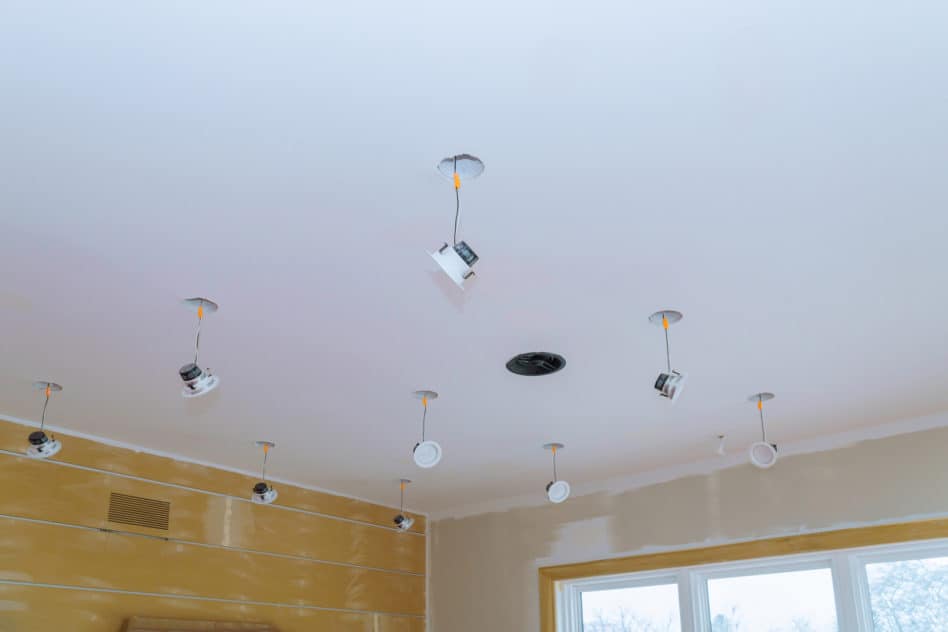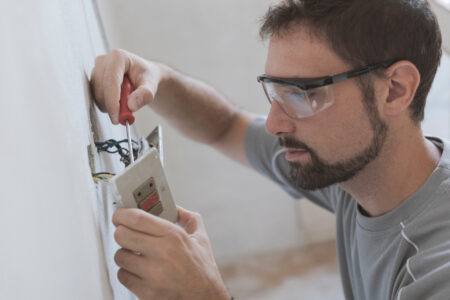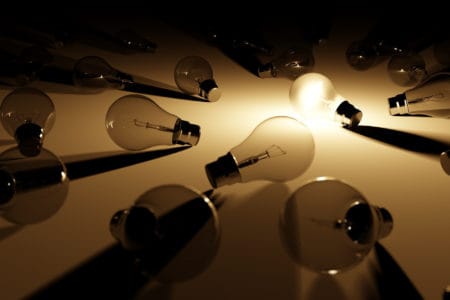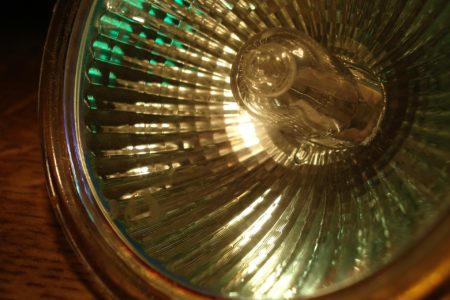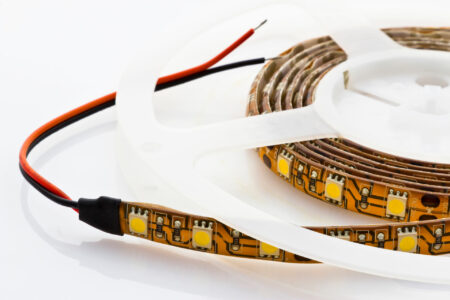Many fires in modern homes have been caused by recessed lighting that overheats and sets fire on flammable insulation materials. This can happen when recessed lights heat up and are in direct contact to the insulation materials. To identify possible hazards with your recessed lights, it is important to understand their IC rating. In this guide we will cover the importance of IC-rated recessed lighting.
Recessed lights vs IC rating
Recessed light is a light fixture that is fitted into a deep cavity in the ceiling. You will have light in your home that seems like coming from a hole in your ceiling. The light is concentrated in a downward direction which can be a broad floodlight or a narrow spotlight. There are some homeowners who don’t want fixtures projecting from the ceiling and so the best way to light up their homes is by using recessed lighting.
With recessed lighting fixtures, you have lighting that is very attractive and encompassing. However, when installing the canisters, spaces are formed where air can pass. During winter, warm air rises into the attic and is replaced by cold air entering the home through doors and windows that are poorly sealed. Like the air moving in a chimney, this upward airflow makes the home more difficult to heat and it wastes a lot of energy.
This effect can be avoided by sealing the spaces around the recessed lighting canisters installed. However, not every recessed type fixture can be stuffed with insulation. You should consider the two types of recessed can lights. These are the IC-rated recessed lights and the non-IC rated lights.
What are IC-rated recessed lights?
IC stands for insulation contact. The design of IC-rated fixtures is for installation in places where they are in direct contact with insulation. This cannot be true for non-IC rated recessed lighting. If they come in contact with insulation, it can create a fire hazard. Most IC-rated lights are rated for 75 watts and a maximum of 100 watts. When following the 100 watts limit, the chances of causing a fire are greatly reduced with the IC rating.
The best way to minimize heat loss through spaces in the fixture is by having IC-rated fixtures since covering them with insulation poses no risk. These fixtures only work with bulbs that are of low wattage and if the bulb exceeds the wattage limit, a thermal protector will trip or turn off the light if the fixture gets too hot.
Non-IC rated lights hove no thermal protection which prevents the fixture from getting too hot. When the lighting overheats, it can burn the surrounding surface and cause a fire. Non-IC rated lights can cause a fire because its housing comes in contact with the home insulation.
Differences between IC-rated and non-IC rated recessed lights
Recessed fixture housing comes in different types. This is why it is important to choose the right one. Consider the type of ceiling you have and how the fixture will be affected by heat. If overheating occurs it can be very dangerous, especially if the fixture touches the insulation material. The solution to this problem is the creation of an IC rating.
If there are less than 3 inches between the fixture housing and the insulation, then the fixture must be IC-rated. IC-rated housings have a heat protection. And the reason why manufacturers limit wattage is that these fixtures have the light source near the trim which produces more glare.
If the fixture is non-IC rated, then there should be a buffer between the housing and the insulation material of at least 3 inches because this type of housing lacks the heat protection that an IC-rated housing has.
Difference in construction
IC-rated fixtures are assembled with a double can design. It is a can within a can. There is an air gap between the 2 cans. This space insulates the outer can from the heat. This makes the outer can cooler. With a cooler outer can coming in direct contact with insulation, the risk of combustion is reduced. The heat generated by the lighting fixture is controlled as the outer can remains cool enough which prevents overheating.
Non-IC fixtures are constructed with a single can. This housing has holes in them for ventilation. You can use non-IC fixtures in places where it is not necessary to have insulation. Because of the open-air surrounding the fixture, heat is easily dissipated. Non-IC fixtures were often preferred because you can use higher wattage or brighter bulbs with it.
Difference in usage
There are more applications for IC-rated fixtures than their non-rated counterpart. The reason for this is that IC-rated lighting can be used in both insulated and non-insulated ceilings. Non-IC rated lighting should not come in contact with ceiling insulation so that proper flow of heat is allowed. A 3-inch space is required to allow for proper flow of heat. This requires building an insulation dam or creating a specially-designed cover for it.
This specially-designed cover can be placed over the fixture on the attic side. You can make a box made of foil-face foam insulation or drywall. When the cover is put in place, it can then be insulated so that it can be more efficient. It is thus important to use the right kind of insulation and to know its fire rating when using non-IC rated fixtures. If the ceiling has no insulation, then non-IC rated fixtures can be used.
Difference in appearance
The color of IC-rated fixtures is silver. Non-IC rated fixtures are white in color.
Difference in price
You can buy non-IC rated recessed lights at lower prices than IC-rated fixtures. The reason for this is that IC-rated fixtures have a more complicated construction then non-IC rated lighting. If there are already existing walls in your home, then you are required to use IC-rated remodel housing.
If you have a brand new space or there is no drywall yet, then it is ideal to use non-IC rated housing. It is also good for uninsulated ceilings. IF you want your lights to operate safely in your home, make sure to check out their IC-rating before buying your lighting fixtures.
What is the importance of the IC rating of recessed lights?
Safety
With IC-rated recessed lights, you can be sure that your home will be safe. There will be no chance of fire hazards occurring in your ceiling with IC-rated lights.
Money savings
With IC-rated recessed lighting, you avoid unnecessary repair costs. You don’t need to frequently ask an electrician to check your light fixtures. With IC-rated fixtures, moisture condensation, which is the major cause of electrical problems, is unlikely to happen.
Efficiency
Energy is saved with IC-rated recessed lights because of the insulation covering it. Heat is not lost through the fixtures. With IC-rated fixtures, you don’t encounter problems of blinking lights. Blinking lights are the result of overheating bulbs.
How to tell if recessed lighting is IC or non-IC rated
It is easy to know a non-IC rated can light since you will see glowing insulation around them. This is caused by the light shining through the ventilation holes in the housing. You can also take the bulb out and look inside the fixture. If the color is white inside, then it is a non-IC rated fixture. If it is silver then it is an IC-rated light. Or, look at the label. The letters IC are in most model numbers of IC-rated fixtures.
Insulation choices
If you are insulating your ceiling with a non-IC rated recessed lighting, the best insulation to use is the least flammable one. This is rock wool. It only burns at a temperature of 1,800 degrees Fahrenheit. No recessed fixture can generate this kind of temperature.
Fiberglass is another safe insulation for your ceiling. Fiberglass is light, less rigid, and can easily be stuffed into small areas. Loose-fill cellulose is recycled paper treated with flame retardant. This is the most hazardous insulation material. At 450 degrees Fahrenheit, the material can begin smoldering.
Rock wool is the best insulation and it also has the best fire rating. The worst material is cellulose. If you have a non-IC rated fixture, this insulation material should not come within 3 inches of the fixture. Otherwise it could smolder and catch fire. But any insulation material can be packed around IC-rated fixtures.
Conclusion
When deciding on what light fixture to place in your recessed lighting, the question to ask yourself is if the ceiling will be insulated or not. An insulated ceiling is required to have an IC-rated housing to eliminate it from being a fire hazard. Otherwise, you can opt for a non-IC rated canister. If you are not using IC-rated fixtures, then safety can become a major issue.
If you want your loved ones and your home to be a safe place to live in, go for recessed lighting that is IC-rated. Aside from the safety issues, another great thing about IC-rated fixtures is that you don’t have to worry whether your ceiling has insulation or not since they can be used in both. With recessed lighting, you can add functionality and visual appeal to your home while providing adequate illumination to space.
